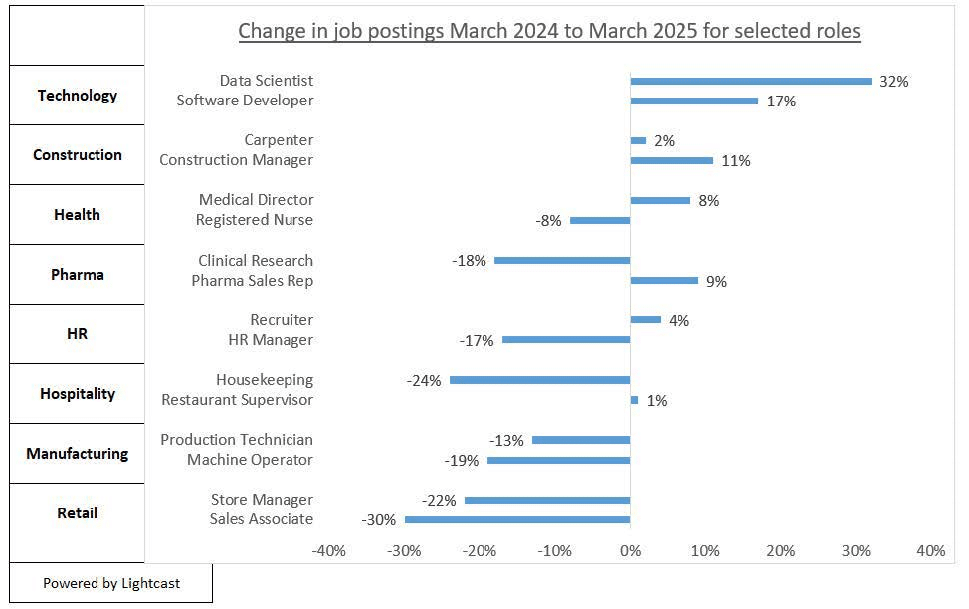Despite slowdowns in job postings across some sectors, HR recruiter positions are quietly on the rise. One expert says this counterintuitive trend could be more than an anomaly—it may be an early indicator of hiring rebounds in select industries.
Stefan Gaertner, Ph.D., senior director of strategy at global pay transparency solution Syndio, notes that “the steady demand for HR recruiters” was the most surprising finding in the company’s latest labor market analysis. While postings have declined year over year in many fields, Gaertner says, recruiter roles have climbed, particularly in tech hubs like Seattle, New York and San Francisco/Silicon Valley.
Why are recruiters in high demand?
The reality is that hiring still needs to happen, even when labor conditions are challenging. In fact, Gaertner says, recruiters are typically hired to address staffing needs for positions that are hard to fill. He adds that this pattern often applies to sectors like tech, health and life sciences, suggesting that the increase in recruiter hiring reflects strong anticipated demand for these skilled roles rather than a broad hiring wave.
This could mean that talented recruiters are a hot commodity for HR hiring teams—and Syndio’s research isn’t the only evidence. Robert Half’s 2025 Demand for Skilled Talent report found that recruiting professionals are one of the most sought-after HR role categories this year. The firm also discovered that HR executives rank talent acquisition and recruitment as their top strategic priorities for the year ahead.
Andrew Flowers, chief economist at programmatic recruiting platform Appcast, weighs in, saying that June’s job gains are boosted by an unusual jump in education jobs, likely due to seasonal adjustments. However, he says, private sector growth slowed, with hiring concentrated in healthcare, restaurants and government.
How can HR leaders justify investing in talent acquisition when many companies are still cutting costs? “Investment will happen quite selectively,” Gaertner says, “with a net increase in recruiter hiring because the jobs that need to be filled are about highly skilled scarce talent.”

What do recruiter job postings indicate?
Gaertner underscores that “job postings are an ideal early indicator for future labor market conditions,” predicting that the uptick in recruiter jobs could be a potential signal that companies are preparing to ramp up hiring where talent is scarce.
However, he is quick to clarify: “I think that the increase in recruiter hiring may not indicate across-the-board increases in hiring, but increases in hiring for selected jobs that are hard to fill.” According to Robert Half, 63% of companies plan to expand their workforce this year, with the strongest hiring intentions in legal, nonclinical healthcare, marketing and finance teams.
When it comes to HR tech, building a modern recruiting infrastructure is part of a forward-looking strategy. A 2025 academic report found that companies using AI in recruitment experienced a 50% reduction in time-to-hire and significant cost savings.
Recruiting is probably the area in HR that is embracing AI the most, Gaertner says. Tools powered by AI and machine learning have made candidate searches easier, yet human recruiters remain essential for outreach, screening and early negotiations. According to Gaertner, “the key elements of a recruiting infrastructure are technology and manpower.”
Do recruiters need new skills?
While AI streamlines workflows, Gaertner doesn’t see a shift in the types of recruiters being hired. “The basic skill set is the same,” he explains, indicating that candidate sourcing, relationship building and initial pay discussions haven’t been taken over by tech.

Recruiters have new AI-based tools to increase their effectiveness, but Gaertner says he “wouldn’t go as far as saying that this requires retraining or a new breed of talent,” largely because the HR tech tools are intuitive and easy to use.
What is changing, he notes, is that “recruiters are spending more time on the phone with candidates and hiring managers, and less time doing administrative work.”
Avoid ‘rear-view mirror’ leadership
Gaertner warns against reactive workforce strategies, which he dubs “leadership through the rear-view mirror.” He cites the tech hiring boom of late 2020 and early 2021, followed by mass layoffs in 2022 and 2023, as an example of miscalculated forecasting.
He warns that today’s shifting economic conditions might tempt business leaders to repeat that mistake. “Right now, the shock to the system is tariffs,” he points out.
Organizations need to carefully weigh the odds of disruption and plan accordingly, according to Gaertner. He says tariffs could stimulate domestic production, leading to more hiring and investment—but with the caveat that retaliatory tariffs could hit certain industries harder than others.
When asked if the recruiter hiring trend is global, Gaertner says, his research is based on U.S. data but acknowledges that “protectionism through tariffs and other means is a global trend.” He says this dynamic could lead to increased hiring in wealthier, import-heavy countries while curbing opportunities in export-driven economies.
There’s much to consider, but for CHROs and business leaders, Gaertner’s advice is clear: “What’s required more than ever is deliberate action and workforce planning—an alignment of workforce strategy with long-term business planning.”



